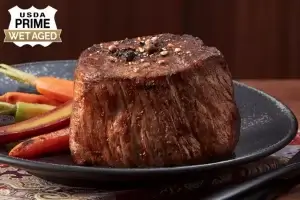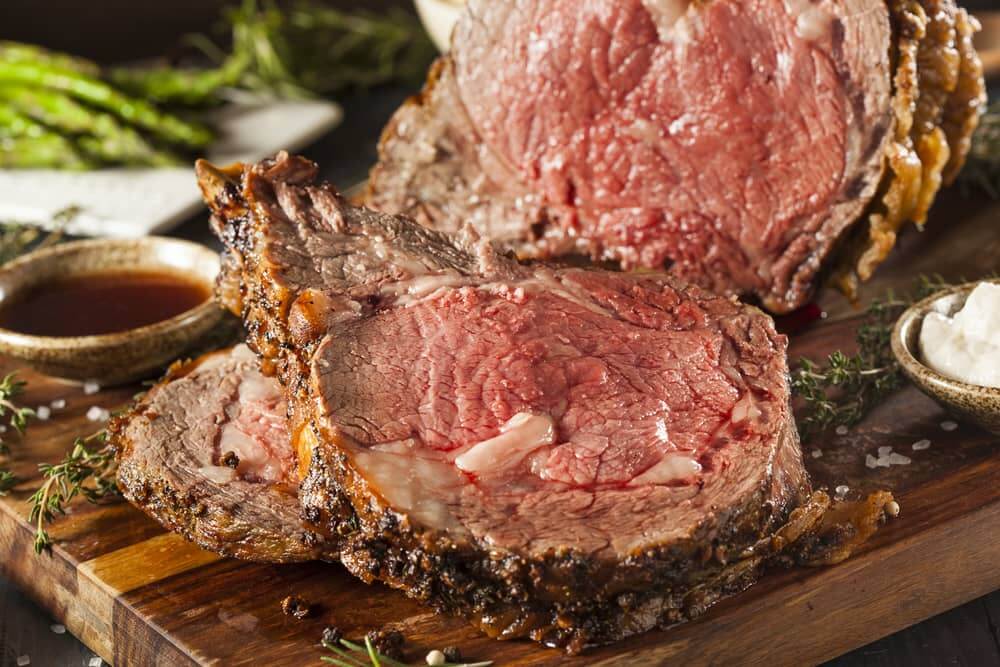
Cooking New York rib roast, prime rib roast, or any other type of rib roast is simple once you learn the ins and outs of your oven or grill settings and temperatures. Getting the proper cook time on a rib roast is crucial in making this cut of steak as tender as possible with the perfect outside sear.
The rib roast comes from the same spot of the cow that a ribeye does, right in the rib area. The ribeye actually comes from the prime rib section before it’s cooked. The full prime rib cut, then, is what turns into a rib roast. Since it’s such a thick cut, it’s not like some other steaks that you can pan fry for a couple of minutes on each side. Instead, cooking a rib roast takes some time, and you’ll need to learn how to cook rib roast for the right amount of time to avoid undercooking or overcooking.
What is the Difference Between Prime Rib Roast and Other Roasts?
When looking for a roast to bring home from the grocery store, butcher, or online meat supplier, you might see different variations of roasts: prime rib roast, ribeye roast, standing rib roast, and beef roast, for example. What’s the difference between all these different roasts?
In some cases, there won’t be much of a difference. Some places just call roasts by different names than others even though they’re the same meat cuts. In reality, though, there is usually a difference between various rib cuts, and you’ll want to understand them before you pay for something you didn’t want.
The two common types of roasts you should know about are the ribeye roast and the prime rib roast. A prime rib roast is also known as a standing rib roast. This cut comes from the primal rib section of a cow and usually includes seven or eight ribs.
The ribeye roast also comes from this same area but usually includes a different section of ribs that’s fattier and less muscle-filled than the standing rib roast. You’ll see more marbling in this cut, then, than you would a prime rib roast, but you can expect the flavors of each roast to be similar.
A New York roast is another one you’ll probably see when you shop. This cut comes from the strip loin and is usually much leaner than the prime rib or ribeye roast. Some say that it doesn’t have quite as much flavor because it’s not as fatty and marbled, but it’s still incredibly tender and tasty.
Selecting Your Roast
When it comes to choosing your roast, you can’t really go wrong with any of your options. However, you might want to skip packages labeled simply as “roast beef” because you don’t necessarily know where that roast beef cut came from. You could end up with a dry, chewy cut of highly muscled meat. Instead, look for a roast that’s clearly labeled by its primary cut.
You can cook a New York roast, prime rib roast, ribeye roast, or your choice of roast as bone in or a boneless cut. But the one you pick will change the method of cooking just a bit. Boneless versions may take a little more time to cook in the oven or grill, but they’ll also guarantee a juicier outcome if you cook them correctly. Some people prefer boneless cuts simply because you won’t need to mess around with bones when you’re ready to eat.
If you’re unsure of the size roast you’ll need, you can use this rule of thumb: estimate about ½-pound for each person who’ll be eating the roast. Then, head to your local butcher or grocery store (or find the perfect prime rib online!) to find the size you need. You’ll want to look for a portion with some fat, but not swimming in it. You can always ask the butcher to trim some excess fat off the roast before they wrap it for you.
If you’re looking for a prime rib roast, you might have a choice to make. Many butchers cut the prime rib roast into two roasts because it’s such a large cut. Of course, you can buy the full cut if you need it. But if you only need one, your butcher might ask you if you want the first or second cut.
The first cut will include the 10th to 12th ribs, which consists of the rib-eye part. The second cut has more connective tissue, making it a bit less tender than the first cut. The pricing may differ slightly between the two, so consider that when you decide which cut you want for your roast.
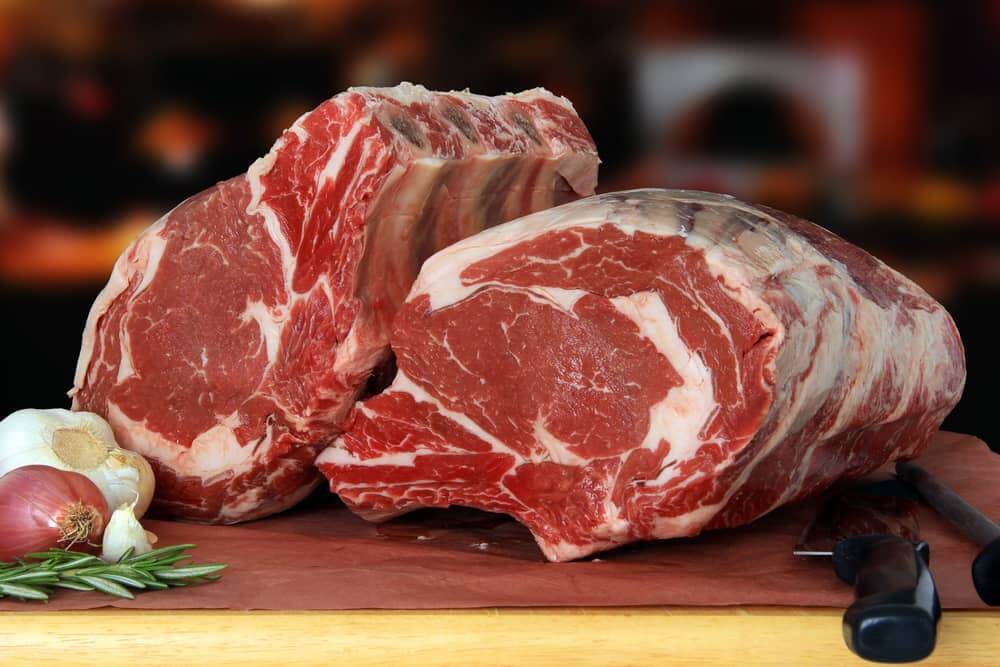
Preparing to Cook Your Roast
Before you cook the perfect prime rib roast or ribeye roast, there are a few steps you should take, regardless of the cooking method you plan to use or the ribeye or prime rib roast recipe you want to follow.
First, if you bought a bone-in roast, decide if you want to remove the bones. Keeping the bones intact can help you avoid overcooking your meat (it takes longer for bone-in roasts to cook), but they can also get in the way of allowing your seasoning to penetrate the meat. You can cut the bones out yourself to season the roast and use butcher’s twine to hold them back in place if you prefer them there while cooking.
Next, you’ll score the fat cap that sits on top of the roast. The fat cap has its advantages, like breaking down as the roast cooks to flavor and tenderize the meat. However, it also can get in the way of your seasonings. Make cross-hatched cuts in the fat cap to allow your seasonings to reach the roast.
Finally, choose the seasonings you want to use. Feel free to play around with this part, but be sure to use plenty of seasoning. And salt is a must, as it helps tenderize the roast as it cooks. Consider using plenty of salt, black pepper, and garlic powder. You might also use thyme and your other favorite herbs. For best results, mix all seasonings together and rub the mixture generously into all sides of the meat. Then, allow to sit for at least one hour before cooking.
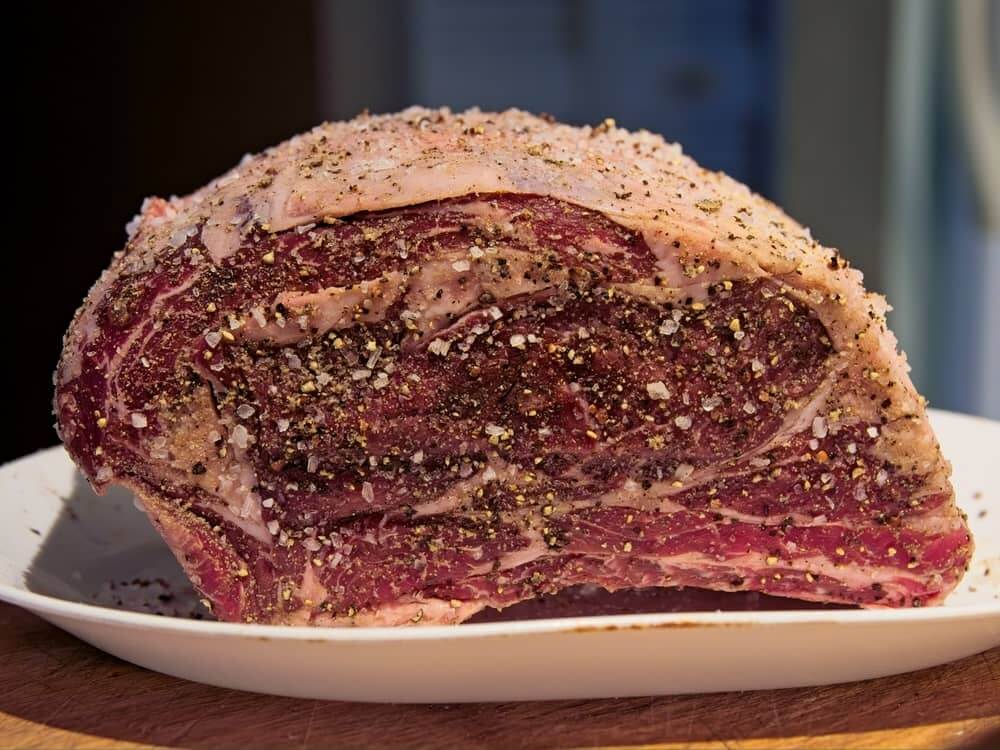
How to Cook a Rib Roast in the Oven
Cooking a roast in the oven tends to be the preferred method. A roast in the oven can get the perfect medium-rare cook that most steak enthusiasts prefer, while also giving it a nice brown crust that enhances the flavor and locks in juices. We’re going to teach you how to use a closed-oven method, which helps your roast sear and cook all the way through without drying out.
Allow your roast to come to room temperature, which can take between two to three hours, before cooking. Season your roast as you preheat your oven to 500-degrees.
Now, calculate the weight of your roast times five. If you have a 5-pound roast, your number will be 25. This is the number of minutes of roasting time needed to give your roast its sear.
Place the roast in a roasting pan with the fatty side facing up. Allow it to roast for the number of minutes you calculated. Then, turn off the oven and allow the roast to cook for another two hours – but don’t open that oven!
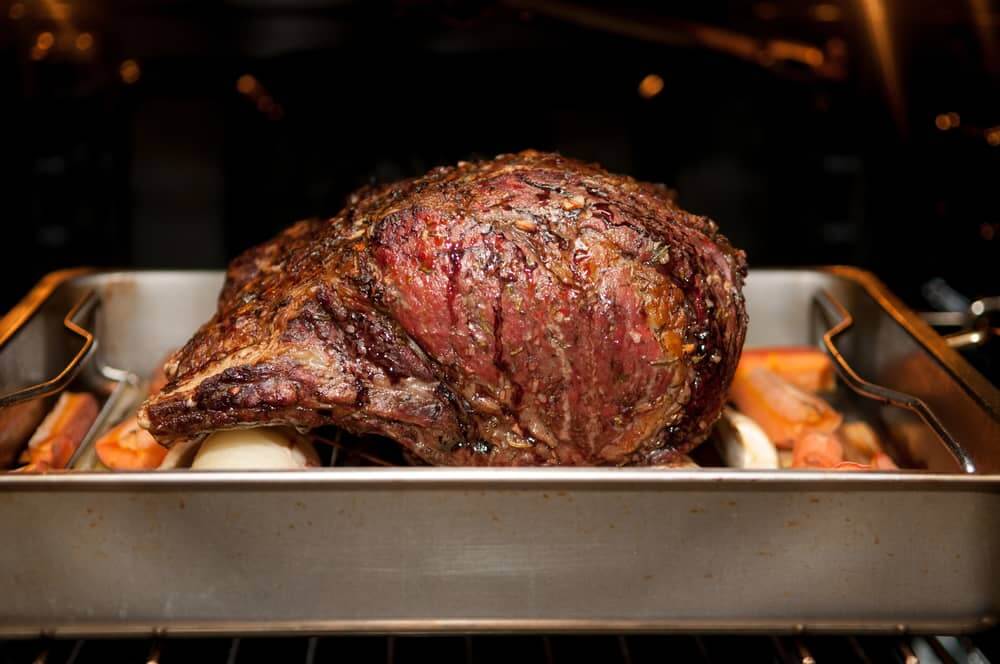
During this time, your roast will continue cooking through so that you’ll end up with a perfectly even, medium-rare doneness. Remove it from the oven and serve immediately.
How to Cook a Rib Roast on the Grill
Cooking a New York roast on the grill will take a little more practice than in the oven. The grill can make for a tricky experience when it comes to cooking a roast, but once you perfect it, you’ll have a deliciously seared roast that’s cooked evenly throughout.
The trick to grilling a roast is searing it first and fast over high heat and then moving it to a lower temperature and allowing it to continue cooking slowly. The sear will not only create a perfect barbecue crust, but it will also lock in those juices that you don’t want to escape.
Before you BBQ, you should add any spices you want to the roast (which you should, again, allow to come to room temperature). Then, heat up all the burners on your grill, allowing one side to heat to high heat and another side on lower heat.
Place your roast on the high heat portion of the grill and lower the cover, allowing the roast to sear for about 5 minutes on each side. Then, move it to the cooler side of the grill. You should plan on it cooking for about an hour for a 2 to 3-lb. roast, but use your meat thermometer to check its internal temperature and doneness.
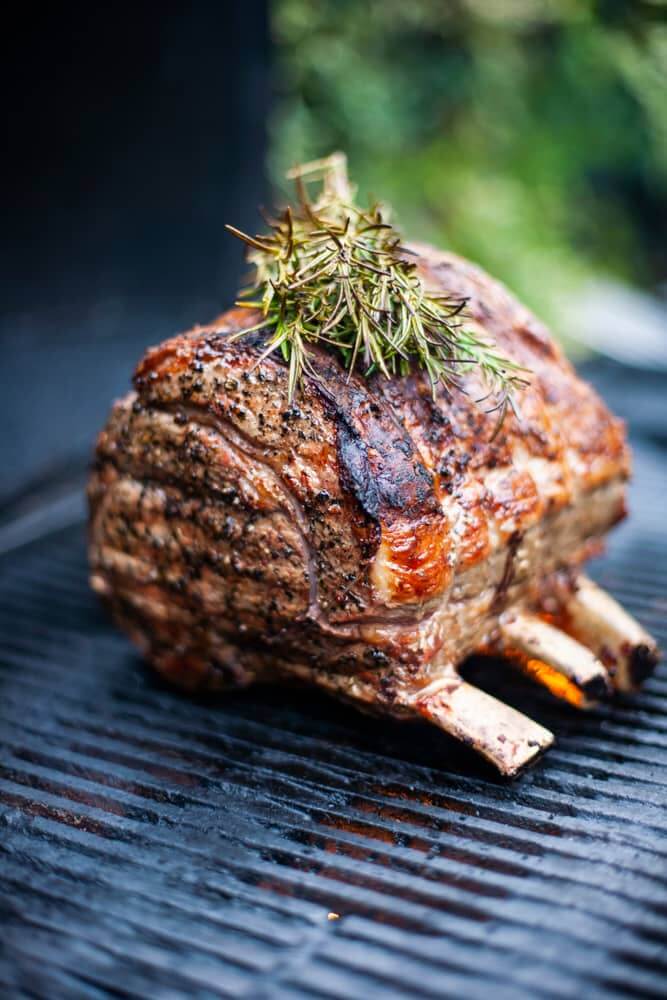
What Temperature Should Rib Roast Be? How Long Should It Cook?
The end internal temperature of your rib roast will depend on how well you like your meat cooked. For rib roast, we recommend cooking to a medium-rare doneness of about 135 degrees. Allowing the roast to rest for about 10 minutes should bring its temperature up a bit more, to about 140 degrees for medium-rare.
With your oven temperature set to 350 degrees, you can expect your roast to take between one and three hours to cook. You’ll need between 15 and 20 minutes per pound. For a small four-pound roast, that’s about 1 to 1 ½ hours. A larger eight-pound roast will need closer to 2 to 2 ½ hours.
How to Serve Rib Roast
After cooking your rib roast, allow it to rest at room temperature for about 10 minutes. This lets the juices absorb back into the meat, and the roast will continue to cook a bit during this time. After the resting period, you can begin to carve it. Start by removing twine if you used it. Then, carve the roast into slices up to one-inch thick.
There are many ways to serve rib roast, including going basic with a little bit of au jus or beef broth drizzled over the slices. Others prefer a red wine drizzle, a garlic herb butter sauce, or beef gravy to top the meat. Of course, going completely bare is perfectly fine, too!
As for sides, there are plenty of excellent companions to choose from. One prime rib favorite is Yorkshire pudding, a staple for serving British prime rib dishes. Risotto, mashed potatoes, baked potatoes, and various vegetables all work well with this elevated meat cut.
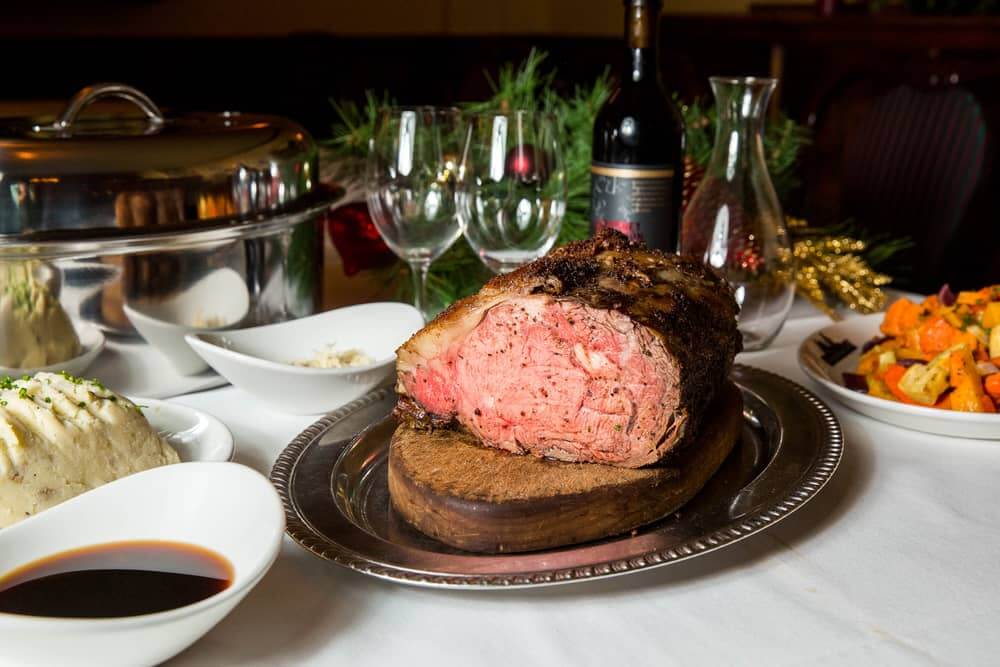
The Best Prime Rib Roast Recipe for the Perfect Prime Rib Roast
Want to know how to cook a rib roast? This prime rib recipe is simple to follow yet results in a tasty, filling meal for the family:
Ingredients
- Standing rib roast
- Your choice of seasoning (we recommend black pepper, salt, and garlic powder, but feel free to experiment with your favorite herbs and spices, like thyme or crushed bay leaves)
- 2 tablespoons of olive oil
Instructions
- Preheat the oven to 350 degrees.
- Brush olive oil on all sides of the roast.
- Combine seasonings together in a small bowl. Rub generously into all sides of the roast.
- Place the roast with its fat cap side up on a wire rack inside a roasting pan.
- Roast the prime rib for 15 to 20 minutes per pound, about 1 ½ to 2 hours for a 5-pound roast.
- Remove the roast from the oven and place on a cutting board for about 10 minutes to rest before carving and serving.
Cooking Tips to Perfect Your Prime Rib Recipe
To boost your chances of cooking a perfect prime rib roast at home, follow these tips:
- Pull the roast from the refrigerator 45 minutes to an hour before you’re ready to cook it to allow it to cook thoroughly and evenly. You can season the roast on all sides during this time.
- Insert a meat thermometer that is designed to stay in the meat while it cooks so that you can consistently monitor the temperature through the oven door as it gets close to your desired doneness.
- Halfway through cooking, baste the roast with its own pan juices to keep it tender.
- Cook the rib roast with the fat side up.
- Keep the rib roast uncovered while you cook it to allow it to brown on the outside. You can also give it a little extra sear in a hot pan for a few minutes on each side after it’s finished roasting.
- Use an electric knife to slice the roast quickly and easily.
Can I Reheat a Prime Rib Roast?
Yes, you can reheat a prime rib roast, but you won’t want to pop it in the microwave for a quick reheat. Doing so can make it lose the juices that keep it tasty and tender. Instead, heat up the oven to a low temperature of 250 degrees. Place the roast on a wire rack inside a roasting pan. Cover loosely with aluminum foil. Roast for one to two hours until you reach an internal temperature of 110 to 120 degrees. If you’ve already sliced your roast, you may only need to reheat it for ½ hour or 45 minutes.
It’ll take more time to do this way than a quick reheat, but it’s worth it to protect the roast’s texture and flavor. If desired, you can sear the roast after pulling it from the oven to brown the outside back up.
Conclusion: How to Cook a Rib Roast in the Oven or on the Grill
Now that you know how to select the best prime rib roast and cook it to perfection, it’s time to bring one home. You don’t have to visit the store to do it. At Chicago Steak Company, we have the highest-quality selection of meats available right at your fingertips. Order online and ship it to your home for your convenience.
Have you tried our Bone-In Heart of Rib Roast? This incredible 8 to 9-lb. piece of tender roast will cook beautifully in the oven or on the grill, thanks to our meticulous aging process for flavor and texture and our secure packaging that keeps it as fresh as the day it was cut. This rib roast is sure to impress, especially now that you know how to cook it. Don’t forget to check out other favorite Chicago Steak Company steaks and assortments for your next big get-together.


